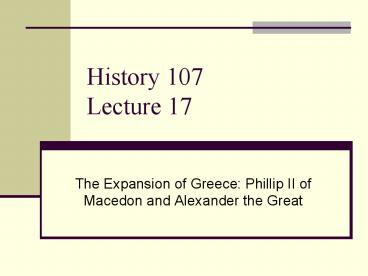History 107 Lecture 17 - PowerPoint PPT Presentation
1 / 11
Title:
History 107 Lecture 17
Description:
Ancient Greece was philosophically, politically, and culturally creative, but ... Dies just two years after invading Greece, leaving a 20-year old heir, Alexander ... – PowerPoint PPT presentation
Number of Views:133
Avg rating:3.0/5.0
Title: History 107 Lecture 17
1
History 107Lecture 17
- The Expansion of Greece Phillip II of Macedon
and Alexander the Great
2
A New Power--Macedon
- Ancient Greece was philosophically, politically,
and culturally creative, but too war-like to
remain unified - From 431 to 338 B.C. it was in constant conflict
- Warring Greeks dont notice developments in the
northern Kingdom of Macedon - This area is known today as Macedonia or the
southern Balkans
3
Philip II of Macedon (r. 359-336 B.C.)
- Philip II became king of Macedon, north of
Greece, in 359 B.C. - He stabilized kingdom through skillful diplomacy,
captured gold mines, and reorganized the army - As a military leader, he optimized the armys
Phalanx formation - Expanded kingdom, which brought him into contact
(and conflict) with Thessaly (northern Greece),
Athens, and Thebes - Greeks asked themselves a question Is this
Philip a dangerous aggressor or the savior of
Greece? Two Views of Philip
Coin with bust of Philip II
4
Philip II of Macedon (r. 359-336 B.C.)
- Athens and Thebes did not trust Philip and
rejected an alliance, so conflicts began - Philip attacked Athens and Thebes in 338 B.C.
(Sparta tries to remain neutral) - Philip creates defensive league among the Greek
poleis sets his sights on Persia - Murdered before he can invade Persia by a
disgruntled lover in Macedonia (336 B.C.) - Dies just two years after invading Greece,
leaving a 20-year old heir, Alexander III
Coin with bust of Philip II
5
Alexander the Great (336 - 323 B.C.E.)
- Alexander III (Alexander the Great) was an
exceptional warrior. Led troops in Battle of
Chaeronea at age 18 - But who was the real Alexander the Great? Legend
vs. reality - New battle style Squads of 16 men with pikes
- Major military conquest Defeats the Persian
Empire. Invades Asia Minor (334 B.C.), Syria
(333), Egypt, Iraq, and Persepolis (330 B.C.) - Persian ruler, Darius III, killed, and Persian
capital city of Persepolis destroyed during
battle - Alexander encouraged Greek nobles to marry
Persian noblewomen, creating a new race of nobles - Continued conquest of Afghanistan in 328 B.C.
- Married Roxane, an Afghani women in Afghanistan
- Continued with conquest in India (Indus river,
battle elephants) - Returned to Babylon in 324 B.C.
6
The Conquests of Alexander the Great
7
Alexander the Great (336 - 323 B.C.E.)
Battle scene depicting Alexander on horseback
(left), Istanbul sarcophagus
8
Aftermath of Conquest
- What Alexander was planning to do with this new,
huge empire is difficult to say - Rather than a systematic administrator, Alexander
may have been more interested in glory and
plunder in the tradition of Greek heroes
(Odysseus) - However, Alexander died after a party (possibly
from infection) on June 10, 323 B.C. - He named no successor, simply smiling that the
strongest should take the empire - Alexander was just 33 years old, and had
personally walked some 20,000 miles in his desire
for glory - Three empires emerged from what Alexander had
created Ptolemaic Egypt, Seleucid Asia, and
Greek Macedonia.
9
Ptolemaic Egypt
- First ruled by a general of Alexander named
Ptolemy, and later called Ptolemaic Egypt - Ptolemys descendants would rule Egypt for the
next 300 years (322 to 30 B.C.), down to Queen
Cleopatra - New capital of Egypt based in Alexandria, a port
city on the Mediterranean established by Alex - Alexandria grew to a major city as scholars
visited and art flourished. Medicine, astronomy,
and anatomy become leading sciences here - At it peak, Alexandria swelled to 500,000 people
and became the center of a vast trading empire - Style of rule Ptolemaic rulers were chameleons
that appeared as Macedonian rulers to the Greek
world but as godlike, semi-divine pharaohs to the
Egyptians
10
Seleucid Asia
- The Macedonian leader Seleucus was not one of
Alexanders generals, but he emerged in 281 B.C.
as the leader of the former Persian empire, which
included much of Asia Minor, Mesopotamia,
Afghanistan, Palestine, and Syria - His descendants were called Seleucids
- Following Babylonian traditions, Seleucuss son
Antiochus called himself the Great King, like
Hammurabi or Darius - Seleucids founded Antioch in Syria, a
Greek-styled city that would become one of the
most important ports on the Eastern Mediterranean - Seleucids also develop professional and
mercantile trades, and parts of Seleucid Asia
thrive
11
Greece and Macedonia
- Back in Macedonia, a general named Antigonus
established control c. 276 B.C. and ruled Greece
and Macedonia - As the Greek city/states chafed under this rule,
various leagues and federations of cities emerged
as an alternate form of political unification - James Madison and Americas founding fathers used
one of these (The Achaean League) as a model when
they advocated Federalism in the early United
States - But the Greece and Macedonia were no longer where
the main action wascommercial and cultural
interests had expanded into Alexandria, Antioch,
and so on































